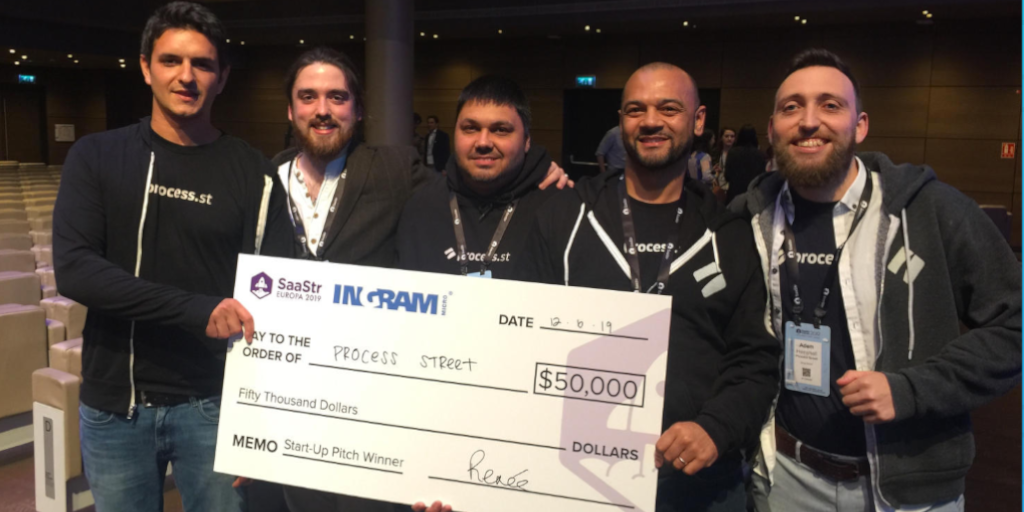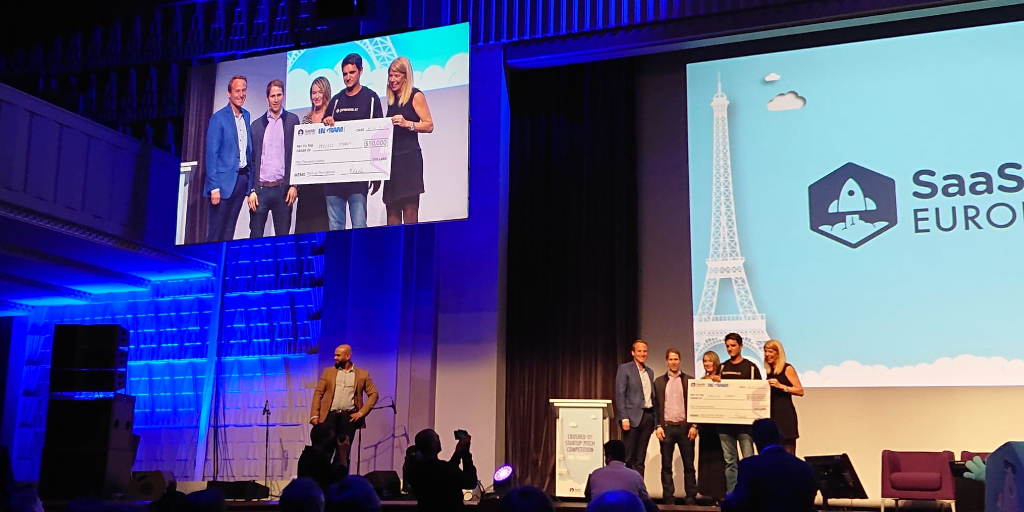
Your average pitch gets examined by investors for about 3 minutes 44 seconds and (if successful) is worth around $1.3 million.
That’s more than $5800 per second.
With figures like that, you need to know how to pitch to land investors, customers, employees, prizes or whatever it is you’re aiming for.
That’s where we here at Process Street come in.
We pitched to over 2500 top SaaS professionals and investors at SaaStr Europa 2019, walking away with the grand prize from the pitch competition, the contact details of several venture capitalists, and collaboration opportunities for months to come.
However, I’m getting ahead of myself. In this post I’ll show you;
- How to pitch: the basics
- What the SaaStr pitch competition was
- The pitch deck we used to win it
- The results and prizes in detail
- The lessons you can learn from our experience
- The secret technique we used to get even more out of our pitch
Let’s get stuck in.
How to pitch: the basics
Anyone who knows how to pitch to investors, at a competition or otherwise will tell you that your pitch needs to answer the following questions:
- What’s the problem you target?
- Who are you?
- How do you solve it?
- Why you?
- Why now?
- What’s your expertise?
- What concrete success/growth have you had?
- Do you have any social proof?
- What’s your competition?
- How are you going to expand further?
Anything beyond that is gravy.
Answering these questions lets your audience know everything they need to decide whether or not they want to be a part of your company. Whether they’re investing or considering becoming a customer, this is the base information you need to include.
Who you are, the problem you’re tackling, and how you’re solving it shows the basic premise of your business. The problem you’re solving, in particular, is important, as it is directly tied to how much you can ultimately grow.
If you don’t give a sense of how widely applicable your company is and how widespread the problem you solve is felt, you handicap any chance of investors seeing the potential growth of your company.
A company with no room to grow won’t attract investors.
The answers to “why you”, “why now” and “what’s your expertise” builds on the growth potential by showing why they should trust you with their money or business.
This is what sets you apart from your competition and should give your audience the confidence they need to know that, well, you know what you’re doing.
Current success and social proof demonstrate what audience you’ve currently got and how they’re reacting to your company as it currently stands.
Take a moment to think of things from a potential investor’s point of view; there’s a promising company with plenty of room to grow and the expertise to make it work. So far so good, but now they will want to see how your current performance stacks up to the potential you’ve already laid out.
You need to use your success and social proof to show that you’re not all talk – you’re tackling things from the right angle and getting the attention from the right target audience.
The final questions on your competition and growth plan are a kind of future-proof guarantee for investors. The answers should show that you’re tackling the competition in a way that can’t easily make you obsolete, with a (brief) plan backing it up to show how you’re going to either keep up the growth pace or compound it further.
SaaStr Europa 2019: The pitch competition
It’s all well and good to create a pitch in a vacuum but we here at Process Street don’t like doing things by halves. That’s why we took our pitch deck to SaaStr Europa 2019.
The event was spectacular – based in Paris a hair’s breadth away from the Notre Dame (still under repair after a fire two months prior), SaaStr Europa 2019 had over 200 VCs attending amongst thousands of others including CEOs, investors, and more.
After a day of talks, networking, and glorious sunshine, the first afternoon was rounded out by a pitch award competition.
With over 500 entrants and top investors, partners and industry veterans serving as judges (Jason Lemkin, Renee Bergeron, Alex Kayyal and Ashley Smith) it was far from a cakewalk. We were narrowed down along with four other companies to pitch at the event itself in front of 2500+ attendees to take a shot at claiming one of the following prizes:
- $50,000 for the company Most Likely to Be a Unicorn
- $25,000 for Best Strategy + Vision
- $25,000 for Best Team
- A sponsorship at SaaStr 2020 for the audience’s favorite
Any of these would be a huge boost but the high stakes only serve to drive the point home here.
We’re not telling you how to pitch from nowhere. We’re telling you from the experience of being on stage with a very public audience, no editing, and a piece of $100,000 on the line.
Oh, and we had just three minutes to make our pitch instead of the usual five-minute guideline.
The pitch deck
As a quick side-note, if you’d like to see what all the fuss is about after reading our pitch deck, why not try out Process Street by signing up for a free account today?
We’re a piece of BPM software that lets you create super-powered checklists with powerful features like due dates, form fields, conditional logic and role assignments.
Stop leaving your success up to chance and human error – sign up for a free account today!
The results

As you can see, we walked away with the grand prize. Our pitch wasn’t perfect but we covered enough ground (and the business was solid enough) that Process Street earned the title of the Most Likely to Be a Unicorn.
Userlane won the prize for Best Strategy + Vision while Tonic App walked away with both the Best Team and audience favorite award.
While it was fun posing behind a novelty cheque for the first time, I won’t pretend that the other companies didn’t come close. Their pitches were great (especially Tonic App) and why they won awards.
So what does this tell us about how to pitch and what can you learn without having to travel to Paris and perform a pitch in front of 2,500+ people?
The lessons for how to pitch (from experience)
You can sit safely in the knowledge that the basic format from earlier does indeed work.
Our pitch deck followed that basic format almost to the letter and we walked away with a $50k prize, along with very little feedback on how to improve. One of the only criticisms we faced was that we spoke a little too fast. Considering that we were the only ones to stay within the 3-minute time limit though, that would easily be solved by taking the 5 minutes that others took.
However, what we learned from experience is that there are plenty of ways you can follow that basic format and still trip up.
Basic pitch points

Using the pitch deck from earlier, we were able to cover a lot of the basic questions essential to knowing how to pitch. We told people what the problem was, who we were, how we solved the problem, gave growth, competition, predicted future statistics and social proof all with a snazzy presentation and cramming in as much information as possible.
This couldn’t be said of some of the other pitches.
I won’t point fingers but the judges were universal in calling out companies that didn’t make their problems obvious enough or didn’t say how they were solving it. When pitching you can’t afford to be vague.
The problem with doing this, in particular, is that you’re giving a bad first impression. Instead of knowing exactly what you’re talking about and how widespread the issue you’re solving is, your audience is left confused or unsatisfied as you go on to the part where you’re selling your company.
They won’t buy into your company if they don’t know exactly what it is in the first place. Explain too little and you’ve already lost them. Repeat it too much and you’re wasting precious time that could be better spent.
The most common complaint was that not enough pitches mentioned the competition they face or gave solid numbers to back up their current success.
As I mentioned earlier, it’s all good to walk and talk about grand plans of success when you don’t have anything to show that you’re meeting those grand expectations. There will always be room to grow and improve (hence why you’re pitching investors in the first place) but you need to give your audience a sense of security through showing that you can realistically meet your potential.
Finally, the only major criticism that we faced (along with the majority of the pitch finalists) was that we didn’t give enough of a spotlight to our team.
These are the people that are carrying out your vision. They’re the ones who’ll be working to capitalize on any investment you can get, meaning you need to reassure investors that the team you have knows what they’re doing and are happy with their jobs.
Unhappy team members are far more likely to leave, meaning any potential investment will partially go into training a replacement rather than being put to full use.
If we had been given a full five minutes then we would have shown our team members, from Vinay (our CEO) and our editors (Adam Henshall and myself) to our sales team, promotion team, and VAs, we have some of the most amazing people I’ve ever had the pleasure to work with. Not to mention that our combined expertise is formidable.
The one team which truly shone in presenting their team was Tonic App. They outlined their core members all by name, showed how all of them had years of expertise relating to the problem they were solving, and displayed pictures of the team interacting in person and generally having a blast.
One of the four awards at SaaStr Europa being for the “Best Team” should tell you exactly how important it is to show them when learning how to pitch.
How to deliver your pitch

The way that you deliver your pitch is just as (if not more) important as the content in your pitch deck. In particular, you need to:
- Talk clearly and with confidence
- Convey your points in language anyone can understand
- Speak directly to your investors
- Rehearse to avoid awkward pauses
- Do more than repeat the information on your slides
Speaking confidently and clearly does the basic job on enforcing what you’re trying to demonstrate through your pitch – that you know what you’re doing and investors can rely on you and your company.
Speaking in simple language isn’t quite so straightforward, as the simplicity varies depending on your pitch and audience. You need to be comfortable with terms that show your expertise but avoid jargon, buzzwords, and anything that can be stated in a better way.
Next, you should address your investors directly. The pitch is designed to sell your company, yes, but it’s also designed to inspire confidence and interest in potential investors. That means you need to be saying “you” almost as much as you say “we”, if not more so.
As with any important speech, you need to rehearse your pitch to make speaking it natural and avoid any uncertain pauses. This shows how prepared you are and that you can be trusted to put together (and act on) a solid plan.
Finally, it’s a good idea to try and separate what you say from what you show. Use your slides to cover the essential information that your investors need time to take in and analyze while you provide extra context and information.
There’s nothing more boring than watching a presentation where the speaker parrots everything you can read for yourself.
How to go above and beyond
There are several ways to stand out from the competition when it comes to learning how to pitch more effectively. We at Process Street used the talents of our in-house graphic designer to create high-quality animations and custom slides to emphasize the quality of our work.
Don’t underestimate the power of animation in re-enforcing your points.
Once again, however, it was Tonic App that struck gold with their presentation, and it was all thanks to the human elements that are intrinsically woven into their company and mission.
Tonic App is designed to allow doctors to directly connect with their peers across the world to quickly diagnose difficult cases. This is a worldwide problem (medical bureaucracy and mismanagement) with extremely tangible human consequences (faster diagnosis means better treatment).
While Process Street has more widespread uses than Tonic App, they had the advantage of a much more human benefit (health as opposed to productivity and consistency). This tied in beautifully to their greater focus on their team to create a coherent view of their company and goals.
In other words, they took full advantage of what separated them from the other finalists. It was close but this ultimately netted the Tonic App team with both the Best Team and Audience Favorite awards.
The secret technique

Unlike most other finalists (at least, judging from their presentations), we had an ulterior motive for presenting our pitch in the way that we did. A secret technique if you will. It all stemmed from knowing how to pitch ourselves as effectively as we could with the audience we had.
We weren’t just pitching to the judges as potential investors. We also pitched our company to the entire audience at the same time.
This is another reason why our pitch deck had animations. It’s also why the pitch was worth more than just the $50,000 prize.
Winning was fantastic and generated a lot of conversation the next day at the event but the real gold was the number of teams who approached us to say that they’d seen the pitch and were interested in our company. Again, I won’t name names but we won more than a few customers, guest post opportunities, collaboration projects, and more.
Not to mention that our final slide advertised our jobs page to everyone present – we pitched to investors, customer, and potential employees.
While this isn’t applicable in sales pitches or investor pitches alone, when pitching in a competition with a live audience this lets you get so much more out of your entry. The key is balancing your pitch deck to be appealing to both potential customers and investors alike.
Practice how to pitch and learn through your mistakes
There you have it – how to pitch directly from an experience involving 2500+ of the top SaaS professionals, judged by some of the most qualified to do so. Other than the tips laid out above there’s only one (slightly cliche) thing to say.
Learn from your mistakes.
If you make a pitch and don’t get any interest, ask your audience why they weren’t interested and find out what they wanted to see more of. If it was something you can’t help (eg, a reluctance to invest in your market) then see how you can find those who will be interested. Anything that you can improve o, do so.
From all of us at Process Street, best of luck and happy pitching.
Do you have any tips on how to pitch that you’d like to share? We’d love to get a discussion going in the comments below!







 Workflows
Workflows Projects
Projects Data Sets
Data Sets Forms
Forms Pages
Pages Automations
Automations Analytics
Analytics Apps
Apps Integrations
Integrations
 Property management
Property management
 Human resources
Human resources
 Customer management
Customer management
 Information technology
Information technology



Ben Mulholland
Ben Mulholland is an Editor at Process Street, and winds down with a casual article or two on Mulholland Writing. Find him on Twitter here.